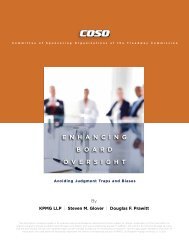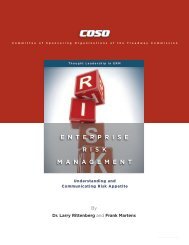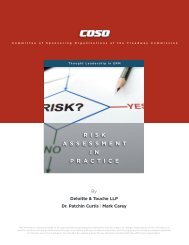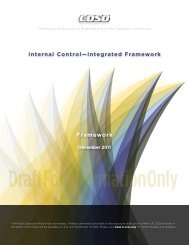Embracing Enterprise Risk Management: Practical - Coso
Embracing Enterprise Risk Management: Practical - Coso
Embracing Enterprise Risk Management: Practical - Coso
Create successful ePaper yourself
Turn your PDF publications into a flip-book with our unique Google optimized e-Paper software.
4 | <strong>Embracing</strong> <strong>Enterprise</strong> <strong>Risk</strong> <strong>Management</strong>: <strong>Practical</strong> Approaches for Getting Started | Thought Leadership in ERM<br />
This is also an appropriate time to lay the groundwork<br />
for the organization’s risk culture including how to best<br />
communicate a desire for more effective risk management.<br />
This initial communication may be focused at senior level<br />
executives to emphasize the importance of the initial ERM<br />
effort and the critical nature of these activities. Subsequent<br />
communications can be directed at describing the ERM<br />
effort in more general terms for a broader audience across<br />
the organization.<br />
Step 2.<br />
Select a Strong Leader to Drive the ERM initiative<br />
Finding a leader to head the initial ERM project is also<br />
critical for success. <strong>Management</strong> should identify a leader<br />
with the right attributes (see box below) to head the ERM<br />
effort. This person does not need to be a “CRO” (Chief <strong>Risk</strong><br />
Officer). Often, it is best to initially use existing resources,<br />
for example the Chief Audit Executive or Chief Financial<br />
Officer, for this role to get ERM started. This leader will not<br />
necessarily be the person to head ERM long term, but the<br />
person to get the initiative started and to take responsibility<br />
for moving the organization’s ERM activities to the next level.<br />
It is critical that the risk leader have sufficient stature<br />
and be at an appropriate senior management level in the<br />
organization to have a rich strategic perspective of the<br />
organization and its risks and to be viewed as a peer by<br />
other members of senior management. Embedding ERM<br />
into the business fabric of the organization is necessary.<br />
Having a risk leader who can be viewed as a peer by<br />
members of senior management is vital for the success of<br />
the ERM initiative.<br />
Attributes of Effective Leaders of <strong>Enterprise</strong> <strong>Risk</strong> <strong>Management</strong><br />
• Broad knowledge of the business and its core strategies<br />
• Strong relationships with directors and executive management<br />
• Strong communication and facilitation skills<br />
• Knowledge of the organization’s risks<br />
• Broad acceptance and credibility across the organization<br />
Step 3.<br />
Establish a <strong>Management</strong><br />
<strong>Risk</strong> Committee or Working Group<br />
To provide strong backing for its ERM effort, an organization<br />
should consider creating a senior-level <strong>Risk</strong> <strong>Management</strong><br />
Committee or Working Group as the vehicle through which<br />
the designated risk leader can implement the ERM initiative.<br />
w w w . c o s o . o r g<br />
While the use of a committee or working group in addition to<br />
the risk leader can be viewed as optional, these committees<br />
have been used by risk leaders as an effective means to<br />
engage the right people across the organization to ensure<br />
success of their ERM efforts.<br />
Ideally, such committees or working groups would include<br />
“C-suite” level executives as well as key business unit<br />
leaders to ensure that the organization’s ERM efforts are<br />
firmly embedded within the organization’s core business<br />
activities. Engaging senior executives at this level also<br />
ensures ERM receives appropriate attention and support<br />
and it can be very useful in building and communicating<br />
the risk culture across the organization. And it provides top<br />
executives with the opportunity to share their insights about<br />
the types of risks that could impede the organization’s ability<br />
to achieve its business objectives, which will be important<br />
information during the initial risk assessment.<br />
Typically, the organization’s ERM leader, as described in<br />
step 2 above, would head this committee and use it as a<br />
principle forum for implementation of ERM. Alternatively,<br />
an organization could create a committee and use the<br />
committee solely for the purpose of implementing ERM. With<br />
this approach, a risk leader or Chief <strong>Risk</strong> Officer could then<br />
be named at a later point as the organization matures its<br />
ERM processes and decides it needs a dedicated leader.<br />
Step 4.<br />
Conduct the initial <strong>Enterprise</strong>-wide<br />
<strong>Risk</strong> Assessment & Develop an Action Plan<br />
In many ways, this step is the heart of the initial ERM<br />
process. The focus here is to gain an understanding of and<br />
agreement on the organization’s top risks and how they are<br />
managed. The assessment is a top-down look at the risks<br />
that could potentially be most significant to the organization<br />
and its ability to achieve its business objectives. While any<br />
organization faces many risks, the starting point is to get a<br />
manageable list of what are collectively seen as the most<br />
significant risks. Here, members of the risk committee or<br />
working group can be most helpful by sharing their views or<br />
identifying people in the organization who should be involved<br />
in the risk assessment.<br />
While there is no one best way to conduct a risk<br />
assessment, many organizations start by obtaining a<br />
top-down view of the most important risk exposures<br />
from key executives across the organization. This is<br />
typically accomplished by starting with a discussion of the












